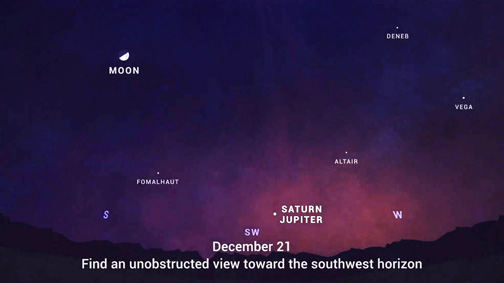By Mary O’KEEFE
The great conjunction of Jupiter and Saturn has already begun and will appear closest to each other on Dec. 21.
Although some refer to this as the “Christmas Star” it is actually not a star at all. On Dec. 21, Jupiter and Saturn will be 0.1 degree apart. For many it will still look like two stars but others may see one elongated star.
In 1623, the two planets traveled together across the sky. Jupiter caught up to and passed Saturn. It has been nearly 400 years since the planets have passed this close to each other in the sky and nearly 800 years since the alignment of Saturn and Jupiter occurred at night, according to NASA.
“You can imagine the solar system as a racetrack with each of the planets as a runner in their own lane and the Earth toward the center of the stadium,” said Henry Throop, astronomer in the Planetary Science division at NASA headquarters in Washington. “From our vantage point, we’ll be able to see Jupiter on the inside lane, approaching Saturn all month and finally overtaking it on Dec. 21.”
To see the phenomenon. An hour after sunset, people can look to the southwestern sky. Jupiter will look like a bright star and be easily visible. Saturn will be slightly fainter and will appear slightly above and to the left of Jupiter until Dec. 21 when Jupiter will overtake it and they will reverse positions in the sky.
Each night, the two planets will appear closer and low in the southwest in the hour after sunset as illustrated in the graphic.

